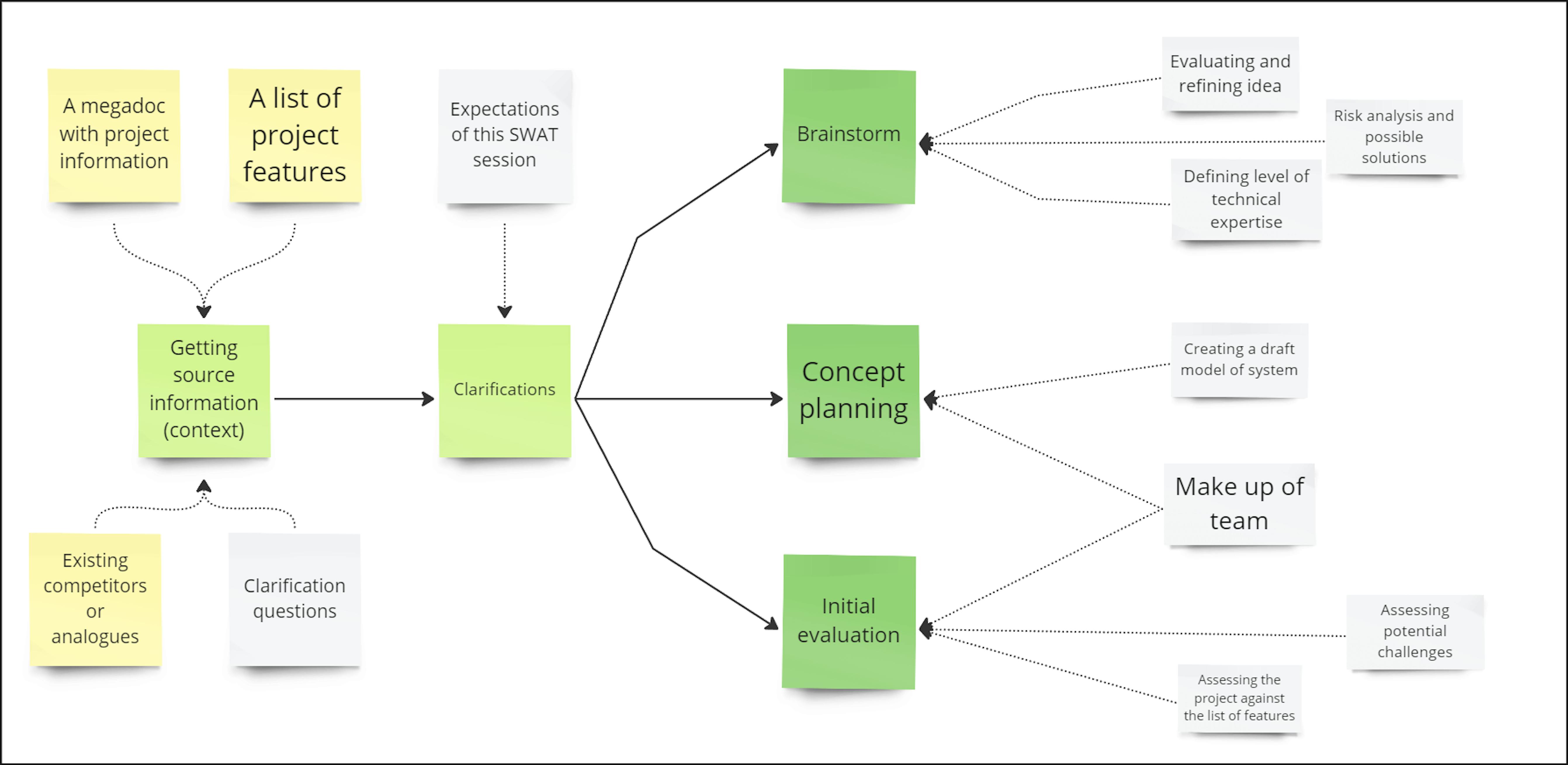After reading the title, you may be imagining a team of software engineers breaking down your door to fix bugs or improve your software's performance. While that would be interesting to see, the SWAT team we're going to describe is about delivering value to our clients without any broken doors. At Mad Devs, we focus on ensuring that our customers will benefit from anything we develop for them. This approach prioritizes our client's business success over any other goals.
Doing this requires thorough planning and regular revision of our plans. It means being prepared for any situation that could arise during a project. That is why Mad Devs can bring together a group of people whose objective is to resolve various challenges and issues: a SWAT team.
What is the SWAT team?
Since this isn't a universal term, the concept of a "SWAT" team can differ from company to company in project management. For example, it can refer to a group of software engineers on a project responsible for ongoing support and responding to crisis situations while their teammates develop new features and implement changes to enhance the product.
Another understanding of this concept is a group of experts or skilled individuals who are quickly assembled to address critical issues or problems within a project. This team typically consists of cross-functional members with the specific skills needed to resolve a particular problem efficiently.
Mad Devs combines both of these understandings. We'll share more details later in the article. Overall, a SWAT team isn't called in to handle any regular situation. The problems they work with require skilled and experienced professionals who can provide answers and solutions that may not be obvious to others. At Mad Devs, having this team demonstrates our expertise to clients in various areas and our commitment to resolving their problems. In terms of urgent problems in projects, we aim to reduce such situations, but it's nice to have this option available when unforeseen circumstances require quick solutions.
SWAT vs SWOT
When spoken, both of these terms sound very similar, but they are used in completely different ways in project management. A SWAT team is used to resolve project issues quickly. On the other hand, SWOT refers to a planning approach that identifies a business's or project's "strengths, weaknesses, opportunities, and threats." A SWOT analysis helps teams understand internal and external factors that could affect the success of a project or business venture and is commonly used in the initial planning phases of a project to set strategic direction. In a situation that requires a SWAT team, the problem has already been identified, and the main aim is to find a solution.
Both of these concepts are useful for businesses of any size that want to ensure they're approaching their projects with the greatest care and responsibility.
The Mad Devs SWAT Team
We call in our SWAT team in the following situations:
- Evaluating business ideas: When a potential client approaches us with a fresh business idea that lacks project documentation. The SWAT team evaluates the feasibility of the idea, creates a concept for a solution, and narrows down a key functionality
- Assessing incoming projects: A delivery manager (DM) looking for projects could ask the SWAT team to define technical restrictions and provide an approximate assessment of the work involved in an incoming project. The DM can use this information to create a budget for the project that the client can use to discuss the details.
- Consulting on challenging technical tasks: If a team on a current project encounters challenges, they can ask the SWAT team for consultations on finding a solution to the problem.
For each of these cases, the team organizes a SWAT session, which follows this structure:
- Confirming the participants
- Stating the goals of the session
- A quick description of the session's format for those unfamiliar with it
- The DM provides a short description of the context
- The DM states their expectations for the session
Our team also ensures that:
- No one monopolizes the conversations to give everyone a chance to speak
- There's a written record and a recording of the session
- The session creates specific results
- The DM is satisfied with the session and understands their next steps
Having this clear structure ensures our SWAT team brings maximum value to every session and our company as a whole.

Gathering a SWAT team
At Mad Devs we want to ensure our SWAT team is available to assist our colleagues and customers at any time, which is why we strive to have at least five individuals on the team. This number covers each day of the working week. Each day, one team member is "on duty" to answer questions and provide support. If this individual can't resolve an issue alone, they know how to bring the rest of the team members together to help.
Here are the guidelines we follow when choosing candidates for our SWAT team:
✅ 5-6 years of active experience in tech and 10 years overall background in the field
✅ Match the team's needs at the moment
✅ Able to work independently with little or no supervision
✅ Problem-solving knowledge and experience for various issues
✅ Flexible to adapt to changing situations and contexts
✅ Able to work under stress on tight deadlines
These parameters match the current needs of Mad Devs; however, we may need to expand the team in the future. Likewise, consider your company's size, the projects it handles, and the resources available to maintain this type of team.
Pros and cons to be taken into consideration
With an understanding of the different concepts of SWAT in software development and how Mad Devs applies this team in our work, it's time to consider this approach's several advantages and disadvantages in resolving development issues. As with any framework or approach to project management, there is no single solution to all the problems that can occur. Every project and business is unique, and it's important to consider small and large details when planning how to organize the work of your teams. These are common advantages and disadvantages that we've encountered and other businesses have as well:
Pros and cons of SWAT teams in software development
| PROS | CONS |
|---|---|
| Rapid problem-solving SWAT teams can address critical issues quickly, bringing immediate expertise to resolve problems that might derail a project. | High resource costs Since an ideal SWAT team comprises specialized personnel with many years of experience, the cost of assembling such a group can be costly, especially for smaller businesses. |
| Specialized expertise These teams are often composed of highly skilled individuals with specific knowledge, making them effective in tackling complex or technical challenges. | Potential team disruption Regular project teams might feel sidelined or demoralized if a SWAT team is brought in to handle an issue they couldn't solve, leading to potential conflicts or disengagement. Likewise, if a group of engineers is tasked as the SWAT team, their expertise is left out of developing new features. |
| Focused effort SWAT teams are usually dedicated to a single problem or crisis, allowing them to work without distractions and achieve results more efficiently. | Short-term focus While SWAT teams are good at solving immediate issues, they may not always address the root causes, leaving the project vulnerable to future problems. |
| Short-term impact By addressing urgent issues in a concentrated time frame, SWAT teams can bring a project back on track without prolonged disruptions. | Over-reliance on SWAT teams Businesses and teams might become too dependent on SWAT teams when they know that these teams can be called in to solve problems. Instead, they should build strong processes and capabilities within the core project team. |
| Increased flexibility Organizations can quickly assemble and deploy a SWAT team when needed, providing flexibility in dealing with unpredictable challenges. | Coordination challenges Introducing an external or separate SWAT team into an ongoing project can create coordination challenges, especially if the SWAT team is not familiar with the project's context or dynamics. |
As with any approach, it's important to take note of the long-term impacts of any decision and to consult stakeholders to ensure problems are solved and not created.
Conclusion
A SWAT team for your software development projects may be a useful idea to ensure your clients' needs are met and that you are prepared for any unexpected issues. However, keep in mind the resources these teams require and focus on developing more efficient processes within your company. As a long-term solution, better processes can improve performance and reduce the chances of unexpected problems that require emergency teams. Also, having a SWAT team can be a useful way to give junior engineers experience with challenging tasks and issues while they learn from senior colleagues. Balancing the advantages and disadvantages of the SWAT team concept will help you reap the most benefits for your business.
Mad Devs offers thorough auditing services to assist you in finding roadblocks and building effective workflows in your software development teams. We'll study your projects and company to develop a keen understanding of your mission and values and assemble an expert team to support you.










